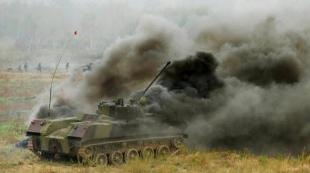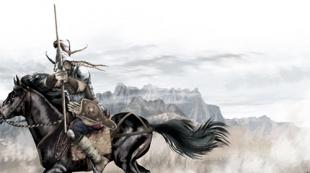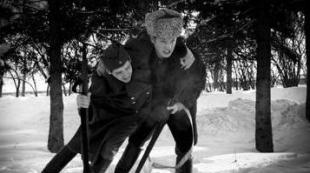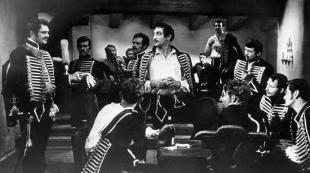Russian-Polovtsian wars: a history of unlearned mistakes. Who are the Polovtsians, how did they appear in Rus'? Polovtsian army
In the 10th century Polovtsians (Kimaks, Kipchaks, Cumans) wandered from the Irtysh to the Caspian Sea. With the beginning of the Seljuk movement, their hordes moved, following the Guz-Torks, to the west. In the 11th century in the Black Sea region, the Polovtsians consolidated the hordes of Bulgarians who had left the Volga, the Pechenegs and Torques into unions subject to them, and developed the lands that became the Polovtsian steppe - Dasht-i-Kipchak.
The Polovtsy who lived along the Dnieper are usually divided into two associations - the left bank and the right bank. Both of them consisted of scattered independent hordes that had their own nomadic territory. At the head of the horde was the ruling clan - the kuren. The family of the main khan (kosh) stood out in the clan. Their greatest influence and power were enjoyed by strong khans - military leaders, for example Bonyak or Sharukan. The Polovtsians raided their neighbors: Rus', Bulgaria, Byzantium. They took part in the civil strife of Russian princes.
The Polovtsian army had the traditional tactics of warfare for nomads - horse attacks with “lavas”, deliberate flight to lure the enemy into attack from an ambush, and in case of defeat they “scattered” across the steppe. Polovtsian troops successfully fought at night (1061, 1171, 1185, 1215). The Polovtsian army, as a rule, consisted of light and heavy cavalry.
Rus''s first acquaintance with the Polovtsians occurred in 1055 in the political field. The reason is the creation of the Pereyaslav principality in 1054 and an attempt to armedly expel the Torci from its territory. The Polovtsians, who were interested in settling the Torci, came to Rus' in peace and solved the problem of their resettlement through diplomatic means.
In 1061, the Polovtsians made their first invasion of Rus' and defeated Prince Vsevolod Yaroslavich of Pereyaslavl. The invasion was caused by a new offensive of Rus' against the Pereyaslav Torci, which violated the Russian-Polovtsian peace treaty.
As part of the Russian army, the armed formations of the Polovtsians took part both as allies (XI-XIII centuries) and as “federates” (XII-XIII centuries), that is, living on the territory of the principality and subject to the current laws of this principality. The Polovtsy, Torques and other “pacified” Turks settled on the territory of Rus' were called “black hoods”. The onslaught of the Polovtsians on Rus' intensified with the change of princely power. Rus' was forced to strengthen the southern border with fortresses in Porosye, Posemye and other regions. Russian-Polovtsian relations were also strengthened by dynastic marriages. Many Russian princes took as wives the daughters of Polovtsian khans. However, the threat of Polovtsian raids on Rus' was constant.
Rus' responded to the raids with campaigns in the Polovtsian steppe. The most effective campaigns of the Russian army were in 1103, 1107, 1111, 1128, 1152, 1170, 1184–1187, 1190, 1192, 1202. More than once the Polovtsians came to Rus' to support one of the disgruntled Russian princes. In alliance with the Russian army, in 1223, the Cumans were defeated by the Mongol-Tatars (Kalka). As an independent political force (Polovtsian steppe), the Polovtsians last attacked Rus': in the east - in 1219 (Ryazan Principality), and in the west - in 1228 and 1235. (Galician Principality). After the Mongol-Tatar conquests of the 13th century. Some of the Polovtsians joined the Mongol-Tatar hordes, others settled in Rus', and others went to the Danube region, Hungary, Lithuania, Transcaucasia and the Middle East.
Campaign of the Russian army against the Polovtsians (1103)
In 1103, the Cumans once again violated the peace. Grand Duke Svyatopolk II Izyaslavich of Kiev (8.9.1050–16.4.1113) and Prince of Pereyaslav Vladimir Vsevolodovich Monomakh (1053–19.5.1125) with their senior squads gathered in Dolobsk for a princely congress - to hold advice on a campaign against the Polovtsians. By the will of the senior princes in Rus', in order to solve a number of foreign policy and internal problems, the druzhina troops of individual lands united under the leadership of the Grand Duke of Rus' and formed an all-Russian druzhina army. At the Dolob Congress it was decided to go to the Polovtsian steppe. The troops of the Chernigov-Seversk land of Oleg (?–18.8.1115) and Davyd (?–1123) Svyatoslavich were invited to the campaign. Vladimir Monomakh left the congress and went to Pereyaslavl to gather his army. Svyatopolk II, taking a retinue army from Kyiv, followed him. In addition to the above-mentioned princes, in the campaign against the Polovtsians, they attracted the squadron troops of Prince Davyd Svyatoslavich of Novgorod-Seversky, as well as princes of the 8th generation: Davyd Vseslavich of Polotsk (?–1129), Vyacheslav Yaropolchich of Vladimir-Volynsky (?–13.4.1105), Yaropolk Vladimirovich of Smolensk (?–18.2.1133) and Mstislav Vsevolodich Gorodetsky (?–1114). Citing illness, only Prince Oleg Svyatoslavich did not go on the campaign. Thus, the all-Russian army in the campaign of 1103 was formed from seven princely troops from various regions of Rus'. And the Russian army went on a campaign. Having passed the boats below the rapids, the troops went ashore near the island of Khortitsa. Then, on horseback and on foot, we went across the field. Four days later they approached Suteni. The Polovtsians knew about the Russian campaign and gathered an army. They decided to kill the Russian princes and take possession of their cities. Only the oldest, Urusoba, was against fighting Russia.
Moving towards the Russian troops, the Polovtsians sent Khan Altunopa at the head of the vanguard. However, the Russian vanguard ambushed Altunopa’s detachment and, surrounding it, killed all the soldiers. Altunopa himself died in the battle. This allowed the Russian regiments to suddenly stand in the way of the Polovtsians on April 4 at Suteni. In the face of the Russian warriors, the Polovtsians “became confused, and fear attacked them, and they themselves became numb, and their horses had no speed in their legs.” As the chronicler writes, “the Russian army attacked the enemy with joy on horseback and on foot.” The Polovtsians could not withstand the onslaught and fled. In battle and pursuit, the Russians killed 20 Polotsk princes: Urusoba, Kochia, Yaroslanopa, Kitanopa, Kunama, Asup, Kurtyk, Chenegrepa, Surbar and others, and captured Beldyuz. After the victory, Beldyuz was brought to Svyatopolk. Svyatopolk did not take the ransom in gold, silver, horses and cattle, but handed the khan over to Vladimir for trial. For breaking the oath, Monomakh ordered the khan to be killed, and he was cut into pieces. Then the prince-brothers gathered, took Polovtsian cattle, sheep, horses, camels, vezhs with booty and servants, captured the Pechenegs and Torques with their vezhs, “and returned to Rus' with glory and great victory.”
Campaign of the Russian army against the Polovtsians (1111)
After the successful campaign of Rus' against the Polovtsians in 1103, the Polovtsians did not abandon raids on the Russian principalities and continued to torment the Russian lands with their devastating raids both in 1106 in the Kiev region near Zarechsk, and in 1107 near Pereyaslavl and Lubna (Polovtsian khans Bonyak, Sharukan in Posulye). In 1107, in the Pereyaslavl principality near Lubno, the troops of the Russian princes of Kyiv, Pereyaslavl, Chernigov, Smolensk and Novgorod principalities gave a worthy rebuff to the enemy on August 19, when at six o’clock in the afternoon they crossed the river. Sulu and attacked the Cumans. The sudden attack of the Russians terrified the Polovtsians and they “could not set up the banner for fear and ran: some clutching their horses, others on foot... chased them to Khorol. They killed Taz, Bonyakov's brother, captured Sugr and his brother, and Sharukan barely escaped. The Polovtsians abandoned their convoy, which was captured by Russian soldiers...” However, the raids continued.
In 1111, “Having thought, the princes of Russia went to Polovets,” i.e. The Russian princes again had a military council and decided to organize a new campaign against the Polovtsians. The united Russian army this time already consisted of 11 squadron troops of the Russian princes Svyatopolk II, Yaroslav, Vladimir, Svyatoslav, Yaropolk and Mstislav Vladimirovich, Davyd Svyatoslavich, Rostislav Davydovich, Davyd Igorevich, Vsevolod Olgovich, Yaroslav Svyatopolchich, i.e. The military power of the Kyiv, Pereyaslavl, Chernigov, Novgorod-Seversky, Novgorod, Smolensk, Vladimir-Volyn and Buzh Russian principalities moved to the Polovtsian steppe. The commanders of the Russian army in this campaign were: Svyatopolk Izyaslavich (Grand Duke of Kiev); Vladimir Vsevoldovich (Prince of Pereyaslavl); Davyd Svyatoslavich (prince of Chernigov) with his son Rostislav Davydovich (appanage prince of Chernigov); Davyd Igorevich (Prince of Buzh, Ostrog, Chertory and Dorogobuzh); Vsevolod Olgovich (Vsevolod-Kirill Olgovich Prince of Chernigov); Svyatoslav Olgovich (appanage prince of Chernigov); Yaroslav Svyatopolchich (Yaroslav (Yaroslavets) - Ivan Svyatopolkovich, Prince of Vladimir-Volynsky); Mstislav Vladimirovich (Prince of Novgorod); Yaropolk Vladimirovich (Prince of Smolensk).
The united Russian army, as a rule, on the battlefield before the battle by the senior commander - the Grand Duke, was divided into three parts: a large regiment - the center, a regiment of the right hand and a regiment of the left hand - the flanks. The balance of forces in the campaign against the Polovtsians was as follows: the eldest among equals in Rus', Prince Svyatopolk II led the regiments of a large regiment, and Vladimir and Davyd, respectively, led the regiments of the right and left hands. In terms of subordination, the subordination of the princes' troops is as follows.
Svyatopolk's army consisted of three regiments, which were headed by: Svyatopolk Izyaslavich (Grand Duke of Kiev); Yaroslav Svyatopolchich; Davyd Igorevich.
Vladimir's army consisted of three regiments, which were headed by: Vladimir Vsevoldovich (Prince of Pereyaslavl); Mstislav Vladimirovich; Yaropolk Vladimirovich.
Davyd's army consisted of three regiments, which were headed by: Davyd Svyatoslavich (Prince of Chernigov) with his son Rostislav; Vsevolod Olgovich; Svyatoslav Olgovich.
In the second week of Lent, the Russian army set out on a campaign against the Polovtsians. In the fifth week of Lent it came to Don. On Tuesday, March 21, having donned protective weapons (armor) and dispatched the regiments, the troops went to the city of Sharuknya, whose residents hospitably greeted them. On the morning of the next day (March 22), the troops moved to the city of Sugrob, the inhabitants of which did not want to submit to their will, and the city was burned.
The Polovtsy gathered an army and, having dispatched their regiments, went out to battle. The battle took place on March 24 on the Degeya stream (“on the Salne Retse field” - in the Salsky steppes). And Rus' won. The chronicle testifies that after the victory on the Degeya stream, the next week - March 27, the Polovtsians with an army of “a thousand thousand” surrounded the Russian troops and began a fierce battle. The picture of the battle is drawn as follows. The large regiment of Svyatoslav II, consisting of several regiments, was the first to engage in battle with the Polovtsian army. And when there were already many killed on both sides, the Russian army appeared before the enemy in full glory - the combined regiments of Prince Vladimir and the regiments of Prince Davyd hit the Polovtsians on the flanks. It should be noted that Russian troops, in the fight against the Polovtsians, usually fight near rivers. This is due to the fact that the nomads used methods specific to them to fight the enemy. Being, by the type of weapons and way of life, light cavalry, their warriors tried to surround the enemy’s army in the steppe and, at full gallop, fired at the enemy in a circular manner from bows, finishing the job they started with sabers, pikes, and whips. By placing regiments near rivers, Russian commanders, using the natural river barrier, deprived the nomads of maneuver, and heavy defensive weapons and the possibility of flanking attacks on the enemy from left- and right-handed regiments already qualitatively changed the picture of the battle.
As a result of the campaign, the Russian soldiers “... and took all their wealth, and killed many with their hands... on Monday of Holy Week, and many of them were beaten.” The battle on the Salnitsa River ended with the complete defeat of the Polovtsian army, which crowned the half-century struggle of Rus' with the Polovtsians with a military triumph, and until 1128 the Polovtsians did not make major raids.
Contents of the article:
Polovtsy (Polovtsians) are a nomadic people who were once considered the most warlike and powerful. The first time we hear about them is in history lessons at school. But the knowledge that a teacher can give within the framework of the program is not enough to understand who they are, these Polovtsians, where they came from and how they influenced the life of Ancient Rus'. Meanwhile, for several centuries they haunted the Kyiv princes.
History of the people, how they came into being
Polovtsy (Polovtsians, Kipchaks, Cumans) are nomadic tribes, the first mention of which dates back to 744. At that time, the Kipchaks were part of the Kimak Kaganate, an ancient nomadic state that formed on the territory of modern Kazakhstan. The main inhabitants here were the Kimaks, who occupied the eastern lands. The lands near the Urals were occupied by the Polovtsians, who were considered relatives of the Kimaks.
By the middle of the 9th century, the Kipchaks achieved superiority over the Kimaks, and by the middle of the 10th century they absorbed them. But the Polovtsians decided not to stop there and by the beginning of the 11th century, thanks to their belligerence, they moved close to the borders of Khorezm (the historical region of the Republic of Uzbekistan).
At that time, the Oghuz (medieval Turkic tribes) lived here, who, due to the invasion, had to move to Central Asia.
By the middle of the 11th century, the Kipchaks submitted to almost the entire territory of Kazakhstan. The western borders of their possessions reached the Volga. Thus, thanks to active nomadic life, raids and the desire to conquer new lands, the once small group of people occupied vast territories and became one of the strongest and richest among the tribes.
Lifestyle and social organization
Their socio-political organization was a typical military-democratic system. The entire people were divided into clans, the names of which were given by the names of their elders. Each clan owned land plots and summer nomadic routes. The heads were the khans, who were also the heads of certain kurens (small divisions of the clan).

The wealth obtained during the campaigns was divided among representatives of the local elite participating in the campaign. Ordinary people, unable to feed themselves, became dependent on the aristocrats. Poor men were engaged in herding livestock, while women served as servants of local khans and their families.
There are still disputes over the appearance of the Polovtsians; the study of the remains continues using modern capabilities. Today scientists have some portrait of these people. It is assumed that they did not belong to the Mongoloid race, but were more like Europeans. The most characteristic feature is blondness and reddishness. Scientists from many countries agree on this.
Independent Chinese experts also describe the Kipchaks as people with blue eyes and “red” hair. There were, of course, dark-haired representatives among them.
War with the Cumans
In the 9th century, the Cumans were allies of the Russian princes. But soon everything changed; at the beginning of the 11th century, Polovtsian troops began to regularly attack the southern regions of Kievan Rus. They plundered houses, took away captives, who were then sold into slavery, and took away livestock. Their invasions were always sudden and brutal.
In the middle of the 11th century, the Kipchaks stopped fighting the Russians, as they were busy at war with the steppe tribes. But then they took up their task again:
- In 1061, the Pereyaslavl prince Vsevolod was defeated in a battle with them and Pereyaslavl was completely destroyed by nomads;
- After this, wars with the Polovtsians became regular. In one of the battles in 1078, the Russian prince Izyaslav died;
- In 1093, the army gathered by three princes to fight the enemy was destroyed.
These were difficult times for Rus'. Endless raids on villages ruined the already simple farming of the peasants. Women were taken captive and became servants, children were sold into slavery.
In order to somehow protect the southern borders, the residents began to build fortifications and settle there the Turks, who were the military force of the princes.

Campaign of Seversky Prince Igor
Sometimes the Kyiv princes went on an offensive war against the enemy. Such events usually ended in victory and caused great damage to the Kipchaks, briefly cooling their ardor and giving the border villages the opportunity to restore their strength and life.
But there were also unsuccessful campaigns. An example of this is the campaign of Igor Svyatoslavovich in 1185.
Then he, uniting with other princes, went out with an army to the right tributary of the Don. Here they encountered the main forces of the Polovtsians, and a battle ensued. But the enemy’s numerical superiority was so noticeable that the Russians were immediately surrounded. Retreating in this position, they came to the lake. From there, Igor rode to the aid of Prince Vsevolod, but was unable to carry out his plans, as he was captured and many soldiers died.
It all ended with the fact that the Polovtsians were able to destroy the city of Rimov, one of the large ancient cities of the Kursk region, and defeat the Russian army. Prince Igor managed to escape from captivity and returned home.
His son remained in captivity, who returned later, but in order to gain freedom, he had to marry the daughter of a Polovtsian khan.
Polovtsy: who are they now?
At the moment, there is no unambiguous data on the genetic similarity of the Kipchaks with any people living today.

There are small ethnic groups considered to be distant descendants of the Cumans. They are found among:
- Crimean Tatars;
- Bashkir;
- Kazakhov;
- Nogaitsev;
- Balkartsev;
- Altaytsev;
- Hungarians;
- Bulgarian;
- Polyakov;
- Ukrainians (according to L. Gumilev).
Thus, it becomes clear that the blood of the Polovtsians flows today in many nations. The Russians were no exception, given their rich joint history.
To tell about the life of the Kipchaks in more detail, it is necessary to write more than one book. We touched on its brightest and most important pages. After reading them, you will better understand who they are - the Polovtsians, what they are known for and where they came from.
Video about nomadic peoples
In this video, historian Andrei Prishvin will tell you how the Polovtsians arose on the territory of ancient Rus':
,
Vladimir Monomakh, Svyatoslav Vsevolodovich,
Roman Mstislavich et al.
Russian-Polovtsian wars- a series of military conflicts that lasted for about a century and a half between Kievan Rus and the Polovtsian tribes. They were caused by a clash of interests between the ancient Russian state and the nomads of the Black Sea steppes. Another side of this war was the strengthening of contradictions between the fragmented Russian principalities, whose rulers often made the Polovtsians their allies and used Polovtsian troops in internecine wars.
As a rule, three stages of military operations are distinguished: the initial (second half of the 11th century), the second period associated with the activities of the famous political and military figure Vladimir Monomakh (first quarter of the 12th century), and the final period (until the middle of the 13th century) (it was part of the famous campaign of the Novgorod-Seversk prince Igor Svyatoslavich, described in “The Tale of Igor’s Regiment”).
Encyclopedic YouTube
-
1 / 5
By the middle of the 11th century. A number of important changes have occurred in the region under consideration. The Pechenegs and Torques, who ruled the “Wild Steppe” for a century, weakened by the struggle with their neighbors - Russia and Byzantium, failed to stop the invasion of the Black Sea lands by newcomers from the Altai foothills - the Polovtsians, also called Cumans. The new owners of the steppes defeated their enemies and occupied their nomadic camps. However, they had to take upon themselves all the consequences of their proximity to neighboring countries. Long years of clashes between the Eastern Slavs and the steppe nomads developed a certain model of relations into which the Polovtsians were forced to fit into.
Meanwhile, the process of disintegration began in Rus' - the princes began to wage an active and ruthless struggle for inheritance and at the same time resort to the help of strong Polovtsian hordes to fight competitors. Therefore, the emergence of a new force in the Black Sea region became a difficult test for the inhabitants of Rus'.
Balance of forces and military organization of the parties
Not much is known about the Polovtsian warriors, but their military organization was considered by contemporaries to be quite high for their time. The main force of the nomads, like any steppe inhabitants, were light cavalry units armed with bows. Polovtsian warriors, in addition to bows, also had sabers, lassos and spears. Rich warriors wore chain mail. Apparently, the Polovtsian khans also had their own squads with heavy weapons. It is also known (from the second half of the 12th century) about the use by the Polovtsians of military equipment - heavy crossbows and “liquid fire”, borrowed, perhaps, from China from the time of their life in the Altai region, or in later times from the Byzantines (see Greek fire ).
The Polovtsians used the tactics of surprise attacks. They acted mainly against weakly defended villages, but rarely attacked fortified fortresses. In field battles, the Polovtsian khans competently divided their forces, using flying detachments in the vanguard to start the battle, which were then reinforced by an attack from the main forces. Thus, in the person of the Cumans, the Russian princes faced an experienced and skillful enemy. It was not for nothing that the longtime enemy of Rus', the Pechenegs, were completely defeated by Polovtsian troops and scattered, practically ceasing to exist.
Nevertheless, Rus' had a huge superiority over its steppe neighbors - according to historians, the population of the ancient Russian state in the 11th century was already over 5 million inhabitants, while there were several hundred thousand nomads. The successes of the Polovtsians were due, first of all, to the disunity and contradictions in their camp opponents.
The structure of the Old Russian army in the era of fragmentation changed significantly compared to the earlier period. Now it consisted of three main parts - the princely squad, personal detachments of aristocratic boyars and city militias. Russian military art was at a fairly high level.
11th century
The truce did not last long. The Polovtsians were preparing a new attack on Rus', but this time Monomakh forestalled them. Thanks to the foray into the steppe of the army under the command of the governor Dmitry, having found out that several Polovtsian khans were gathering soldiers for a large campaign against Russian lands, the Pereyaslavl prince invited the allies to attack the enemy themselves. This time we performed in winter. On February 26, 1111, Svyatopolk Izyaslavich, Vladimir Monomakh and their allies, at the head of a large army, moved deep into the Polovtsian nomads. The army of the princes penetrated as far into the steppes as never before - all the way to the Don. The Polovtsian cities of Sharukan and Sugrov were captured. But Khan Sharukan brought the main forces out of the attack. On March 26, hoping that the Russian soldiers were tired after a long campaign, the Polovtsians attacked the allied army on the banks of the Salnitsa River. In a bloody and fierce battle, victory again went to the Russians. The enemy fled, the prince's army returned home without hindrance.
After Vladimir Monomakh became the Grand Duke of Kyiv, Russian troops made another major campaign in the steppe (led by Yaropolk Vladimirovich and Vsevolod Davydovich) and captured 3 cities from the Polovtsians (). In the last years of his life, Monomakh sent Yaropolk with an army across the Don against the Polovtsians, but he did not find them there. The Polovtsians migrated away from the borders of Rus', to the Caucasian foothills.
XII-XIII centuries
With the death of Monomakh's heir Mstislav, the Russian princes returned to the practice of using the Polovtsians in civil strife: Yuri Dolgoruky brought the Polovtsians under the walls of Kiev five times during the wars with Prince Izyaslav Mstislavich, then with their help Izyaslav Davydovich of Chernigov fought against Rostislav Mstislavich of Smolensk, then the troops of Andrei Bogolyubsky and the Polovtsians were expelled from Kiev by Mstislav Izyaslavich (1169), then Rurik Rostislavich of Smolensk defended Kiev from the Olgovichi and Polovtsians (1181), then Kiev, under the rule of Roman Galician, was defeated by Rurik, the Olgovichi and the Polovtsy (1203), then the Polovtsians were used by Daniil of Volyn and Vladimir Rurikovich Kiev against the Hungarians, and then the Olgovichi against them in the civil strife of the mid-1230s.
The resumption of campaigns of Russian princes in the steppes (to ensure the security of trade) is associated with the great Kyiv reign of Mstislav Izyaslavich (-).
Usually Kyiv coordinated its defensive actions with Pereyaslavl (which was in the possession of the Rostov-Suzdal princes), and thereby a more or less unified Ros-Sula line was created. In this regard, the importance of the headquarters of such a common defense passed from Belgorod to Kanev. The southern border outposts of the Kyiv land, located in the 10th century on Stugna and Sula, have now advanced down the Dnieper to Orel and Sneporod-Samara In the early 1180s, a coalition of South Russian princes led by Svyatoslav Vsevolodovich of Kiev inflicted a decisive defeat on the Polovtsian Khan Kobyak, he was captured along with 7 thousand of his soldiers, and Khan Konchak on Khorol (according to traditional dating July 30, 1183 and 1 March 1185, according to the results of a comparative analysis of chronicles by N. G. Berezhkov, July 30 and March 1, 1184, respectively).
In the spring of 1185, Svyatoslav left for the northeastern lands of the Chernigov principality, preparing go to the Don against the Polovtsians for the whole summer, and the Novgorod-Seversk prince Igor Svyatoslavich undertook a separate campaign in the steppes (this time unsuccessful, unlike the campaign of the previous year). The army of the Seversky prince set out on a campaign on April 23, 1185. On the way, Igor was joined with his squads by his son Vladimir Putivlsky, nephew Svyatoslav Rylsky, Igor’s brother, Prince Kursky and Trubchevsky
The Polovtsians belonged to the nomadic tribes. According to various sources, they also had other names: Kipchaks and Komans. The Polovtsian people belonged to the Turkic-speaking tribes. At the beginning of the 11th century, they expelled the Pechenegs and Torques from the Black Sea steppes. Then they headed to the Dnieper, and upon reaching the Danube they became the owners of the steppe, which became known as the Polovtsian steppe. The religion of the Polovtsians was Tengriism. This religion is based on the cult of Tengri Khan (the eternal sunshine of the sky).
The daily life of the Polovtsians was practically no different from other tribal peoples. Their main occupation was cattle breeding. By the end of the 11th century, the type of Polovtsian nomadism changed from camp to more modern. Each individual part of the tribe was assigned plots of land for pastures.
Kievan Rus and the Cumans
Starting from 1061 and up to 1210, the Polovtsians made constant raids on Russian lands. The struggle between Rus' and the Polovtsians lasted quite a long time. There were about 46 major raids on Rus', and this does not take into account smaller ones.
The first battle of Rus' with the Cumans was on February 2, 1061 near Pereyaslavl, they burned the surrounding area and robbed the nearest villages. In 1068, the Cumans defeated the troops of the Yaroslavichs, in 1078 Izyaslav Yaroslavich died in a battle with them, in 1093 the Cumans defeated the troops of 3 princes: Svyatopolk, Vladimir Monomakh and Rostislav, and in 1094 they forced Vladimir Monomakh to leave Chernigov. Subsequently, several retaliatory campaigns were made. In 1096, the Polovtsians suffered their first defeat in the fight against Russia. In 1103 they were defeated by Svyatopolk and Vladimir Monomakh, then they served King David the Builder in the Caucasus.
The final defeat of the Polovtsians by Vladimir Monomakh and a Russian army of many thousands occurred as a result of the crusade in 1111. To avoid final destruction, the Polovtsians changed their place of nomadism, moving across the Danube, and most of their troops, along with their families, went to Georgia. All these “all-Russian” campaigns against the Polovtsians were led by Vladimir Monomakh. After his death in 1125, the Cumans took an active part in the internecine wars of the Russian princes, participating in the defeat of Kyiv as allies in 1169 and 1203.
The next campaign against the Polovtsy, also referred to as the massacre of Igor Svyatoslavovich with the Polovtsy, described in “The Tale of Igor’s Campaign,” took place in 1185. This campaign of Igor Svyatoslavovich was an example of one of the unsuccessful ones. After some time, some of the Polovtsians converted to Christianity, and a period of calm began in the Polovtsian raids.
The Polovtsians ceased to exist as an independent, politically developed people after the European campaigns of Batu (1236 - 1242) and made up the majority of the population of the Golden Horde, passing on to them their language, which formed the basis for the formation of other languages (Tatar, Bashkir, Nogai, Kazakh, Karakalpak , Kumyk and others).
The departure of the Pechenegs from the Northern Black Sea region caused a void that sooner or later someone had to fill. From the second half of the 11th century, the Polovtsians became the new masters of the steppes. From this time on, a titanic
Russian-Polovtsian wrestling
, which was fought on the broadest front from the foothills of the Carpathians. Unprecedented in its scale, it lasted for a century and a half and had a significant impact on the fate of the Old Russian state.Like the Pechenegs, the Polovtsians did not set the goal of seizing Russian territories, but limited themselves to robberies and deportation. And the ratio of the population of Ancient Rus' and the steppe nomads was far from in favor of the latter: according to various estimates, approximately 5.5 million people lived on the territory of the Old Russian state, while the Polovtsians numbered several hundred thousand.
The Russians had to fight the Polovtsy under the new historical conditions of the collapse of a single state. Now, squads of individual principalities usually participated in the war with nomads. The boyars were free to choose their place of service and could move to another prince at any time. Therefore, their troops were not particularly reliable. There was no unity of command and weapons. Thus, the military successes of the Polovtsians were directly related to internal political changes in the Old Russian state. Over the course of a century and a half, nomads made about 50 major raids on Russian lands. Sometimes the Polovtsians became allies of princes engaged in internecine struggle.
Russian-Polovtsian wars
can be roughly divided into three stages. The first covers the second half of the 11th century, the second is associated with the activities of the prince, the third falls on the second half of the 12th - early 13th centuries.Wars with the Cumans, first stage (second half of the 11th century)
The first attack of the Polovtsians on Russian soil dates back to 1061, when they defeated the army of the Pereyaslavl prince Vsevolod Yaroslavich. Seven years later, a new raid was made. The joint forces of the Grand Duke of Kyiv Izyaslav and his brothers Svyatoslav of Chernigov and Vsevolod of Pereyaslav came out to meet him.
Battle of the Alta River (1068). The opponents met in September on the banks of the Alta River. The battle took place at night. The Polovtsians turned out to be more successful and defeated the Russians, who fled from the battlefield. The consequence of this defeat was a rebellion in Kyiv, as a result of which Izyaslav fled to Poland. The Polovtsian invasion was stopped by Prince Svyatoslav, who with a small retinue boldly attacked a large army of nomads near Snovsk and won a decisive victory over them. Until the 90s of the 11th century, chronicles are silent about major raids, but the “small war” continued periodically.
Battle of Stugna (1093). The onslaught of the Polovtsians especially intensified in the 90s of the 11th century. In 1092, nomads captured three cities: Pesochen, Perevoloka and Priluk, and also destroyed many villages on both sides of the Dnieper. The Polovtsian khans Bonyak and Tugorkan became famous in the raids of the 90s. In 1093, Polovtsian troops besieged the city of Torchesk. The Grand Duke of Kiev Svyatopolk Izyaslavovich came out to meet them with a squad of 800 soldiers. Along the way, he united with the troops of princes Rostislav and Vladimir Vsevolodovich. But having joined forces, the princes were unable to develop joint tactics. Svyatopolk self-confidently rushed into battle. The rest, citing a lack of strength, offered to enter into negotiations with the Polovtsians. In the end, the passionate Svyatopolk, wanting victory, won over the majority to his side. On May 24, the Russian army crossed the Stugna River and was attacked by superior Polovtsian forces. Unable to withstand the blow, the Russians fled to the river. Many died in the stormy waters from the rains (including the Pereyaslavl prince Rostislav Vsevolodovich). After this victory, the Polovtsians captured Torchesk. To stop their invasion, the Grand Duke of Kiev Svyatopolk was forced to pay them tribute and marry the daughter of the Polovtsian khan Tugorkan.
Battle of Trubezh (1096). Svyatopolk's marriage to a Polovtsian princess briefly curbed the appetites of her relatives, and two years after the Battle of Stugna, the raids resumed with renewed vigor. Moreover, this time the southern princes were unable to agree on joint actions at all, since the Chernigov prince Oleg Svyatoslavich avoided the fight and preferred to conclude not only peace, but also an alliance with the Polovtsians. With the help of the Polovtsians, he expelled the prince from Chernigov to Pereyaslavl, who in the summer of 1095 had to repel the raids of nomads alone. The next year, Svyatopolk Izyaslavovich expelled Oleg from Chernigov and besieged his army in Starodub. The Polovtsians immediately took advantage of this discord and moved towards Rus' on both sides of the Dnieper. Bonyak appeared in the vicinity of Kyiv, and the princes Kurya and Tugorkan besieged Pereyaslavl.
Then Vladimir and Svyatopolk quickly moved to defend their borders. Not finding Bonyak near Kyiv, they crossed the Dnieper and, unexpectedly for the Polovtsians, appeared near Pereyaslavl. On July 19, 1096, the Russians quickly forded the Trubezh River and attacked Tugorkan’s army. Not having time to line up for battle, it suffered a crushing defeat. During the persecution, many Polovtsian soldiers were killed, including Khan Tugorkan (father-in-law of Svyatopolk) along with his son and other noble military leaders.
Meanwhile, Bonyak, having learned about the departure of the princes for the Dnieper, almost captured Kyiv in an unexpected raid. The Polovtsians plundered and burned the Pechersky Monastery. However, having learned about the approach of the regiments of Svyatopolk and Vladimir, the Polovtsian khan quickly left with his army in the steppe. After successfully repelling this raid, the Torci and other border steppe tribes began to join the Russians. The victory on the banks of Trubezh was of great importance in the rise of the military star, who became a recognized leader in the fight against the Polovtsian danger.
Wars with the Cumans, second stage (second half of the 12th century)
The external threat made it possible to temporarily slow down the process of disintegration of state unity. In 1103 he convinced Svyatopolk to organize a large-scale campaign against the nomads. From this time on, the offensive stage of the fight against the Polovtsians began, the inspiration of which became. The campaign of 1103 was the largest military operation against the Cumans. The armed forces of seven princes took part in it. The combined troops on boats and on foot reached the Dnieper rapids and turned from there into the depths of the steppes, to the town of Suten, where one of the large groups of nomads led by Khan Urusoba was located. It was decided to set out in early spring, before the Polovtsian horses had time to gain strength after a long winter. The Russians destroyed the advanced patrols of the Polovtsians, which ensured the surprise of the attack.
Battle of Suteni (1103). The battle between the Russians and the Cumans took place on April 4, 1103. At the beginning of the battle, the Russians surrounded the Polovtsian vanguard, led by the hero Altunopa, and completely destroyed it. Then, encouraged by success, they attacked the main Polovtsian forces and inflicted complete defeat on them. According to the chronicle, never before have the Russians won such a famous victory over the Polovtsians. In the battle, almost the entire Polovtsian elite was destroyed - Urusoba and nineteen other khans. Many Russian prisoners were released. This victory marked the beginning of Russian offensive actions against the Polovtsians.
Battle of Luben (1107). Three years later, the Polovtsians, having recovered from the blow, made a new raid. They captured a lot of booty and prisoners, but on the way back they were overtaken by Svyatopolk’s squads across the Sula River and defeated. In May 1107, Khan Bonyak invaded the Pereyaslav Principality. He captured herds of horses and besieged the city of Luben. A princely coalition led by princes Svyatopolk and Vladimir Monomakh came out to meet the invaders.
On August 12, they crossed the Sulu River and decisively attacked the Cumans. They did not expect such a rapid onslaught and fled from the battlefield, abandoning their convoy. The Russians pursued them all the way to the Khorol River and captured many prisoners. Despite the victory, the princes did not seek to continue the war, but tried to establish peaceful relations with the nomads. This, in particular, was evidenced by the fact that after the Battle of Luben, Russian princes Oleg married their sons to Polovtsian princesses.
Battle of Salnitsa (1111). However, hopes that family ties would strengthen Russian-Polovtsian ties and bring peace with the nomads did not materialize. Two years later, hostilities resumed. Then Monomakh again convinced the princes to unite for joint action. He again proposed a plan of offensive action and transfer of the war into the depths of the Polovtsian steppes, characteristic of his military strategy. Monomakh managed to achieve coordination of actions from the princes and in 1111 he organized a campaign that became the pinnacle of his military successes.
The Russian army set out in the snow. The infantry, to which he attached special importance, rode on sleighs. After four weeks of campaigning, Monomakh’s army reached the Donets River. Never since the time of Svyatoslav had the Russians gone so far into the steppe. The two largest Polovtsian strongholds were taken - the cities of Sugrov and Sharukan. Having freed many prisoners there and captured rich booty, Monomakh’s army set off on the return journey. However, the Polovtsians did not want to release the Russians alive from their possessions. On March 24, the Polovtsian cavalry blocked the path of the Russian army. After a short fight she was driven back.
Two days later the Polovtsy tried again.The decisive battle took place on March 26 on the banks of the Salnitsa River. The outcome of this bloody and desperate, according to the chronicle, battle was decided by the timely strike of the regiments under the command of princes Vladimir and Davyd. The Polovtsians suffered a crushing defeat. According to legend, heavenly angels helped Russian soldiers defeat their enemies. The Battle of Salnitsa was the largest Russian victory over the Cumans. She contributed to the growth of popularity of the protagonist of the campaign, the news of which reached “even Rome.”
After the death of the Grand Duke of Kyiv Svyatopolk in 1113, the Polovtsian khans Aepa and Bonyak carried out a major raid in the hope of internal unrest. The Polovtsian army besieged the Vyr fortress. But having learned about the approach of the Russian squads, it hastily retreated without accepting the battle. Apparently, the factor of the moral superiority of Russian soldiers had an effect.
In 1113, he took the Kiev throne. During his reign (1113-1125), the fight against the Cumans was carried out exclusively on their territory. In 1116, the Russian princes, under the command of the son of Yaropolk (an active participant in previous campaigns), moved deep into the Don steppes and again captured Sharukan and Sugrov. Another center of the Polovtsians, the town of Balin, was also taken. After this campaign, Polovtsian dominance in the steppes came to an end. When Yaropolk undertook another “preventative” campaign in 1120, the steppes were empty. By that time, the Polovtsians had already migrated to the North Caucasus, away from the Russian borders. The northern Black Sea region was cleared of aggressive nomads, and Russian farmers could safely harvest their crops. This was a period of revival of state power, which brought peace and tranquility to the lands Ancient Rus'.
Wars with the Cumans, third stage (second half of the 12th - beginning of the 13th century)
After his death, Khan Atrak dared to return to the Don steppes from Georgia. But the Polovtsian raid on the southern Russian borders was repelled by Prince Yaropolk. However, soon the descendants of Monomakh were removed from power in Kyiv by Vsevolod Olgovich - a descendant of another grandson of Yaroslav the Wise - Oleg Svyatoslavovich. This prince entered into an alliance with the Cumans and used them as a military force in his campaigns against the Galician princes and Poland. After the death of Vsevolod in 1146, a struggle for the Kiev throne broke out between princes Izyaslav Mstislavovich and Yuri Dolgoruky. During this period, the Polovtsians began to actively participate in internecine warfare.Here the regiments of the Polovtsian Khan Aepa distinguished themselves. Thus, he led Polovtsian troops to Kyiv five times, trying to capture the capital of Ancient Rus'.
Years of strife nullified efforts to protect Russian borders. The weakening of the military power of the ancient Russian state allowed the Polovtsians to strengthen themselves and create a large unification of tribes in the 70s of the 12th century. It was headed by Khan Konchak, whose name is associated with a new surge in the Russian-Polovtsian confrontation. Konchak constantly fought with the Russian princes, plundering the southern borderland. The areas around Kyiv, Pereyaslavl and Chernigov were subjected to the most brutal raids. The Polovtsian onslaught intensified after Konchak’s victory over the Novgorod-Seversk prince Igor Svyatoslavich in 1185.Campaign of Igor Svyatoslavich (1185). The background to this famous campaign, sung in “The Tale of Igor’s Campaign,” is as follows. In the summer of 1184, the Kiev prince Svyatoslav Vsevolodovich, at the head of a princely coalition, launched a campaign against the Polovtsians and inflicted a crushing defeat on them in the Battle of the Orel River on July 30. 7 thousand Polovtsians were captured, including their leader, Khan Kobyak, who was executed as punishment for previous raids. Khan Konchak decided to take revenge for the death of Kobyak. He came to the borders of Rus' in February 1185, but was defeated in the battle on March 1 on the Khorol River by the troops of Svyatoslav. It seemed like times were returning. Another joint blow was needed to completely crush the revived Polovtsian power.
However, this time history did not repeat itself. The reason for this was the inconsistency in the actions of the princes. Under the influence of Svyatoslav’s successes, his ally, Prince of Novgorod-Seversk Igor Svyatoslavich, together with his brother Vsevolod, decided to receive the laurels of a triumph without anyone’s help and set off on a campaign on their own. Igor's army of approximately 6 thousand people moved deep into the steppes and found themselves alone with all the forces of Konchak, who did not miss the chance given to him by the reckless prince.
Having retreated after the vanguard battle, the Polovtsians, following all the rules of their tactics, lured the Russian army into a trap and surrounded it with much superior forces. Igor decided to fight his way back to the Seversky Donets River. We must note the nobility of the brothers. Having cavalry to break through, they did not abandon their infantry to the mercy of fate, but ordered the mounted warriors to dismount and fight on foot, so that they could all fight their way out of the encirclement together. “If we run, kill ourselves, and leave ordinary people behind, then it will be a sin for us to hand them over to the enemies; we will either die or live together,” the princes decided. The battle between Igor's squad and the Polovtsians took place on May 12, 1185. Before the battle, Igor addressed the soldiers with the words: “Brothers! This is what we were looking for, so let us dare. Shame is worse than death!”
The fierce battle lasted three days. On the first day, the Russians repelled the Polovtsian onslaught. But the next day one of the regiments could not stand it and ran. Igor rushed to the retreating forces to return them to the line, but was captured. The bloody battle continued even after the prince was captured. Finally, the Polovtsians, due to their numbers, managed to grind down the entire Russian army. The death of a large army exposed a significant line of defense and, in the words of Prince Svyatopolk, “opened the gates to Russian land.” The Polovtsy were not slow to take advantage of their success and carried out a series of raids on the Novgorod-Seversky and Pereyaslavl lands.The grueling struggle with the nomads, which lasted for centuries, cost enormous victims. Due to constant raids, the fertile outskirts of the southern regions of Rus' were depopulated, which contributed to their decline. Constant military operations in the steppes of the Northern Black Sea region led to the shift of old trade routes to the Mediterranean region. Kievan Rus, which was a transit corridor from Byzantium to Northern and Central Europe, henceforth remains aloof from new routes. Thus, the Polovtsian raids not least contributed to the decline of Southern Rus' and the movement of the center of the Old Russian state to the northeast, to the Vladimir-Suzdal principality.
By the early 90s of the 12th century, the raids subsided, but after the death of the Kyiv prince Svyatoslav in 1194, a new period of strife began, into which the Polovtsians were also drawn. The geography of their attacks is expanding. The Polovtsians made repeated raids on the Ryazan principality. By the way, the Ryazan prince Roman “with his brethren” organized the last major Russian campaign in history against the Polovtsians in April 1206. During this period, the Polovtsians are already completely moving to the second stage of nomadism - with permanent winter roads and summer roads. The beginning of the 13th century is characterized by a gradual attenuation of their military activity. The chronicle dates the last Polovtsian raid on Russian lands (the vicinity of Pereyaslavl) to 1210. Further development of Russian-Polovtsian relations was interrupted by a hurricane from the east, as a result of which both the Polovtsians and Kievan Rus disappeared.
Based on materials from the portal "









